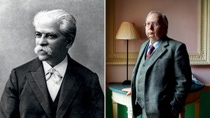Pioneering thinker – then and now: Electricity from chemistry

Pioneering thinker – then
Alessandro Volta: The Italian physicist described the voltaic pile, the first-ever functioning battery, to the Royal Society in London in 1800.

Pioneering thinker – now
Michael Thackeray: The South African-born chemist is a leading scientist in the development of lithium batteries – a key technology in harnessing clean energy.
In Europe at the end of the 18th century, the generation of electricity was a mystery, even considered magical. Carnival entertainers created a fascinating spectacle with simple electrostatic generators. But it was Alessandro Volta who achieved the breakthrough that ushered in the electric age. The scientist and inventor developed the first apparatus which enabled electricity to flow for a longer period.
Volta knew from an early age what he wanted. As a teenager he taught himself the fundamentals of electricity. At the age of 18 he decided to study experimental science, against the wishes of his uncle and guardian. It was the right decision. He later carried out groundbreaking work, especially in the area of electrical science. Volta developed a usable electrophorus, a simple device to generate an electrostatic charge from static electricity. As a physics teacher at the local high school in Como, Italy, in 1776 he discovered the combustible gas methane and used it to construct a device known as Volta’s pistol. The pistol creates an electric spark which causes the methane to combust – a predecessor of the gas lighter. Two years later, Volta became a professor for experimental physics at the University of Pavia in Italy.
It was here in 1787 that his career reached its zenith. Alessandro Volta combined various metals and realized that when they come into contact with one another, the metals become charged to differing degrees – and this creates electric potential. He put this knowledge into practice with his voltaic pile (see box).
Volta’s invention was the first practical, usable source of electrical current. Our entire electrified world – including the lightbulb, electricity generators and electric motors – is based on it. His work formed the foundation for the first mass-produced battery in 1802. Alessandro Volta became famous: The London-based Royal Society awarded him the Copley Medal, the highest scientific honor of that time. Napoleon also admired the scientist and appointed him as a senator and later also made him a count. But Volta did not live to experience his highest honor. In 1881 – 54 years after his death – the first International Exposition of Electricity in Paris named the unit of electric potential after him: the volt.
Growing up in Pretoria, South Africa, Michael Thackeray, PhD, was interested in science from an early age. He first caught the chemistry bug in his second year at the University of Cape Town after discovering the beauty of crystals. “A light went on,” says Thackeray. “I remember saying, I can see myself working in this field.”
After graduating with a Master of Science in chemistry in 1973, the thought of a career in “messy batteries” was farthest from his mind. However, when he joined the Council for Scientific and Industrial Research (CSIR) in Pretoria, the Middle East oil crisis had erupted, triggering a worldwide race to develop rechargeable batteries. Johan Coetzer, Thackeray’s mentor at CSIR, had begun researching crystalline silver-ion-conducting solid electrolytes, giving Thackeray his first insight into relationships between crystal structures and electrical energy. Together, they worked to create new high-temperature sodium and lithium battery technologies.
Thackeray found himself fascinated by the possibilities that lithium offered and applied to work with Professor John Goodenough, a world authority on metal oxides, at the University of Oxford in England. In 1981, he moved with his family to Oxford and began investigating the behavior of spinel oxide electrodes at room temperature (see box). His research on lithium insertion reactions led to the use of a variety of spinel electrode materials in lithium-ion batteries – today’s dominant rechargeable technology in electronic devices and electric cars.
Since 1994, Thackeray has headed a team at the non-profit Argonne National Laboratory in the United States. They have developed materials for a solidstate lithium-polymer battery for stationary energy storage and designed composite electrode structures that improve the performance and safety of lithiumion batteries.
At 67, Thackeray is still working on advancing composite electrodes by including a spinel component in the structure. “This approach looks promising indeed,” he says. “We’re also seeking to exploit the energy from the oxygen in metal oxide structures – a more formidable task.”
The voltaic pile
Alessandro Volta discovered metals as a source of electricity. This finding enabled him to develop the voltaic pile, which was made of zinc and copper discs layered over each other and separated by cardboard soaked in brine. This “galvanic cell” produces electrical voltage as the zinc discs give off electrons, creating an excess of electrons and thus a negative charge.
The copper, on the other hand, absorbs the zinc electrons, creating a shortage of electrons and a positive charge. When the plus and minus poles (the two ends of the voltaic pile) are connected, an electrical current flows. Even today many batteries still work on this principle, such as small-scale hearing aid batteries.
Spinels explained
Spinels are crystals that have a cubic structure, through which lithium ions can move in three dimensions. This structure considerably speeds up the charging and discharging process in a battery as the ions shuttle back and forth between the two electrodes.
At the University of Oxford in England, Michael Thackeray, PhD, discovered that lithium could be inserted into iron oxide and manganese oxide spinels at room temperature, a finding that has resulted in inexpensive and safer electrodes.

